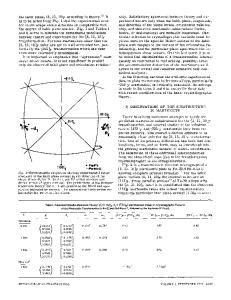{011} Twinning in Fe-Ni-C martensites
- PDF / 3,178,233 Bytes
- 9 Pages / 613 x 789 pts Page_size
- 55 Downloads / 514 Views
I.
INTRODUCTION
S E V E R A L investigations have been devoted to characterization of the morphological and substructural features of ferrous martensites.tL2l Motivation for this work has come partly from a need to understand the influence of the martensitic substructure on the mechanical behavior of these materials. In addition, these substructural features have provided important clues regarding the martensitic transformation mechanism. Previous research indicates that the overall morphology of the individual martensitic units, as well as the types of lattice defects found within the martensitic phase, is influenced by the alloy composition as well as by the transformation temperature. The martensitic units are generally platelike in shape in ferrous martensites having subambient transformation temperatures, tl,21 Plates that form at very low temperatures are usually thin and flat, whereas those forming closer to room temperature tend to be more lenticular in shape. Thin-plate martensite is completely internally twinned. The twinning is of the (liT) {112} type, a common deformation twinning system in bcc crystals. Lenticular martensites are partially internally twinned; the untwinned portion contains a relatively high density of lattice dislocations (with 1/2(111) Burgers vectors) which are often pure screw in character, t3] In addition to these features, other substructural features have been found in ferrous carbon-bearing martensites, t4.5] Most notable are the {011}* planar defects *The tetragonal symmetry of martensite dictates that the absolute value of the underlined index be fixed when obtaining equivalent crystallographic variants.
reported in Fe-C, [4'6'7| Fe-Mn-C, t5'71 and Fe-Cr-C t4,5] alloys, which Roytburd and Khachaturyan t81 and Kurdjumov and Khachaturyan tgl suggest may be {011} twins. In a K.A. TAYLOR, formerly with the Massachusetts Institute of Technology, is Research Engineer with Bethlehem Steel Corporation, Bethlehem, PA 18016. G.B. OLSON, formerly with the Massachusetts Institute of Technology, is Professor with the Department of Materials Science and Engineering, Northwestern University, Evanston, IL 60208. M. COHEN, Institute Professor Emeritus, and J.B. VANDER SANDE, Professor, are with the Massachusetts Institute of Technology, Cambridge, MA 02139. Manuscript submitted August 25, 1988. METALLURGICAL TRANSACTIONS A
cubic lattice, the {011} planes are mirror planes, and, therefore, cannot be twinning planes. However, {011} twinning can occur in tetragonal carbon-bearing martensites. In a fully tetragonal martensite, carbon atoms occupy only one of the three available octahedral interstitial sublattices (the Oc lattice), which results in a macroscopic extension of the c-axis of the martensitic lattice.* Since *Small contractions along the a- and b-axes accompany the expansion along the c-axis.
O, and Ob sites are unpopulated, no lattice expansion occurs along either the a- or b-axis, and thus, the lattice is body-centered tetragonal (bct). The process of {01_1} twinning in a bct lat
Data Loading...











